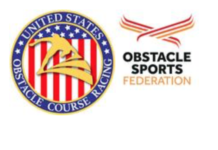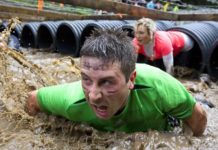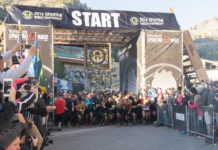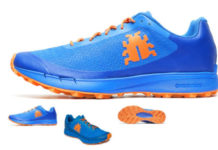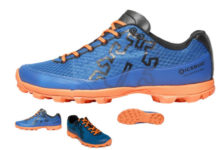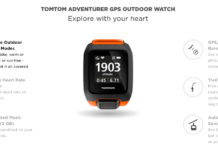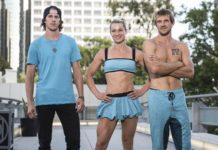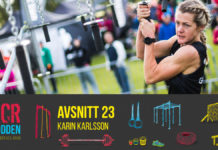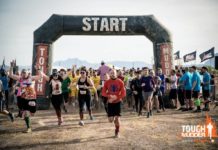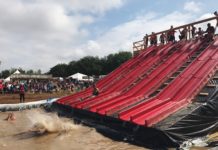This may be one of the murkiest and deepest unknowns of our training and nutrition: hydration. There are a lot of rule of thumbs on the issue that have become “fact” or hard science that most of us are following. When it comes to obstacle racing and running in general, hydration can play a far more important role than calorie intake to sustain the effort! People are mostly concerned with fueling their bodies with enough carbs and fat for the race. This is certainly a great concern, but they fail to properly prepare in terms of hydration. A few percent decrease in hydration can cause an 11-12 % decrease in VO2 output. In other words for those not familiar with VO2 numbers, that’s a HUGE hit you just took in performance because you weren’t properly hydrated.
Common Myths of Hydration:
1. If your urine color is light or clear you are sufficiently hydrated: FALSE.
Certain foods containing various nutrients can easily alter the color of your urine. So while a correlation of urine color to hydration does exist, it is simply a correlation and is far from a causation.
2. If you are drinking a lot of water and you are peeing a lot, your body has enough water that the excess is being pushed out: FALSE.
Just because you are peeing a lot from drinking water does not mean you are actually keeping water in!
3. You should be drinking 8 ounces of water per hour of strenuous exercise such as an obstacle race in order to stay hydrated: FALSE.
Unfortunately, hydration needs during intense/endurance bouts are incredibly different from person-to-person and can differ noticeably based on conditions such as temperature, training status, humidity, nutrient presence, etc.
4. Drinks such as Gatorade, Vitamin Water, and coconut water hydrate you better because of the carbohydrates and electrolytes: FALSE.
We will discuss why carbs can actually cause dehydration and a decrease in performance. Carbs will not necessarily yield good hydration for a Spartan Race or Tough Mudder event.
5. Hydration is the same for men and women: FALSE.
It’s not.
6. Eat a banana and sprinkle salts on your food to ensure you’re getting enough sodium and potassium: FALSE.
There isn’t one type of sodium, and salt from a shaker isn’t going to hydrate you. You also can’t just take in a bunch of potassium to ensure you’re hydrated.
7. Coconut water is an all-natural hydration tool: FALSE.
Coconut water is not a good drink for hydration.
8. Food and hydration together during exercise are killing two birds with one stone: FALSE.
For optimal obstacle race hydration, you want to keep hydration and nutrition separate.
9. The colder it is, the less water you need to drink: FALSE.
Just because it is colder does not mean you do not have to hydrate as well. Most people who fall prey to hypothermia are dehydrated!
Now that we have that out of the way let’s get into some nitty gritty of hydration for obstacle racing. The first mechanism of fatigue (mental and physical) is when blood plasma decreases. Blood plasma is the volume of water in your blood. Once your blood plasma decreases, your blood essentially thickens. Think of the motor oil in your car over time getting thicker and thicker in viscosity, causing a decrease in its overall amount. Not too good, right? The same applies to your blood. Once your blood plasma decreases, your heart rate goes up, you’re breathing heavier, your reaction time is slower, cognitive function decreases, thermoregulation is out the window, and power output goes down as well. To sum it up, bad things happen to you. Most importantly, you’re slowing down in the race!
So what causes hydration then? High quality H2O, duh. But that’s not the only factor in hydration for obstacle racing. The things we should be mainly concerned with in order for hydration in an obstacle race: water, sodium, potassium, and glucose/sucrose/amino acids.
Do you sweat a lot in your sleep regardless if it’s cool in your room or not? Besides having nightmares of being chased by the girl from The Ring, many people sweat because of glycogen (the form of sugar stored in the body) depletion thanks to catabolism. So you can certainly wake up dehydrated thanks to that. Knowing when you are hydrated vs. dehydrated is key. Signs of dehydration are simply a drop-off in power output or performance, slower thought process (a more severe sign is a headache), a lack of sweat when you usually do. You need to know when you are performing badly due to dehydration. If you’ve ever had a training session or race where you felt you were performing amazing and felt unstoppable, you were more than likely properly hydrated. On the other hand, you can most certainly remember a training session or race where you weren’t, because you felt like you were moving through a pool of peanut butter. Delicious, terrible, slow peanut butter…So you will eventually have to test yourself and see what an effective amount of water to drink throughout the day is based on all the factors we discussed earlier. You shouldn’t be running to the bathroom to pee several times a day. Testing on yourself is how you will find success. A construction worker in Miami who weighs 200 pounds and wears a wool sweater might need a little over a gallon a day to include his training sessions. While Susan the 16 year old cross country racer in San Diego who weighs 110 pounds might only need 75 ounces, because most of the day she’s sitting down in class or studying and only trains about 30 minutes a day.
Sodium
Sodium is responsible for expanding blood plasma volume. People will instantly use a saltshaker to solve their hydration needs. Table salt is also known as sodium chloride. Sodium chloride can interfere with the functioning of the intestinal cells, causing gastrointestinal (GI) distress and bloating. What does work well are sodium citrate and sodium bicarbonate. Sodium citrate is easily recognized by our intestines, so it won’t upset your gut and is also a great precursor for aerobic exercise. Sodium bicarbonate is great in small amounts to help pull sodium into the compartments and cells of the body for hydration.
Potassium
Potassium is responsible for all other compartments of water in the body, so it’s also pretty freakin’ important. Most people are deficient in potassium in comparison to their sodium intake. What is more important for those who realize this and attempt to take in a lot of sodium through food and other products is that potassium does not excrete from the body in the same way sodium does. While sodium can be both sweat and urinated out, very little potassium is excreted through sweat.
Glucose/Sucrose/Amino Acids
The importance of these bad boys when talking about hydration is their role in transporting sodium. So while the body needs potassium and sodium to transport water, sodium needs glucose, sucrose, and/or amino acids in order to transport sodium into the cell. Think of them as the tow truck that tows a tow truck already carrying a car. If there aren’t enough of these, there will be a limited rate of flow of sodium and water into the cells when needed. That means a decrease in performance!
Don’t read that last paragraph and think, “So I just need carbs and protein and I’ll be set”. Only a small amount of these are necessary for optimal hydration for obstacle racing. If you have too many (which most people make this mistake) carbs and/or amino acids, it will increase the osmotic pressure of your stomach. But your body is smart, so it will decrease that pressure by pushing the watery mix of carbs/amino acids into your intestines. What stinks about that is your body just used a bunch of water that was meant to be transported into your blood to be fed to your muscles. This is essentially causes dehydration! This might help explain why your sugary hydration drink isn’t really helping you as you intended. Carbs being absorbed is not the goal; we only want a little bit of carbs to ensure proper hydration!
Popular Hydration Products
Gatorade/Vitamin Water: Many of you may have heard that collegiate and professional athletes often dilute Gatorade because there is too much sugar in it. These sugary drinks contain a 6-12% solution of sugar. They are absolutely right to do so. Gatorade contains far too much sugar, and to make things worse it’s not a good source of sugar. Fructose, just like too many carbs will increase the osmotic pressure of the stomach and cause water to be pushed into the intestines, resulting in dehydration. Fructose will also force more water into the small intestines and away from the blood since our stomach doesn’t recognize fructose in comparison to good sources like glucose and sucrose. So is diluting the answer? No, because when we dilute these sugary drinks we also dilute the amount of beneficial sodium and potassium as well.
Hydration tablets: Products that are meant for hydration usually come in the form of an effervescent tablet or a powder. You need to be careful with these products since most of them are sugar free and use sugar alcohols in the form of sorbitol and xylitol (like you would see in sugar-free gum). Sugar alcohols are laxatives that draw water into the large intestines and (once again) out of the compartments and spaces water is used for circulation, thermoregulation, bowel movements, and other processes. The lack of carbs prevents you from rapidly absorbing fluids in your small intestines like you would with proper amounts/types of sugars. That and the fact that these alcohols are laxatives should persuade you to stay away from these products.
Coconut water: This is becoming extremely popular among the organic advocates and the paleo/crossfit scene. Many coconut water products have a lot of potassium in a single serving. This isn’t an issue until people start literally thinking coconut water is simply water and are drinking multiple to several servings a day. Like we discussed earlier, the body does not get rid of potassium as easily as sodium, and too much can become a concern. Further more, coconut water is NOT water. If you ever crack open a coconut there will be the “water” inside, but it is actually JUICE. You’re drinking juice. Yes it’s natural juice but it contains a lot of sugar and therefore can dehydrate you like we talked about earlier.
Electrolyte products: There are products in the form of capsules or powders/solutions that aim purely to provide you with electrolytes. And we finally said it, the golden word. People think electrolytes are these golden gods sent from the heavens. Electrolytes are simply a compound that can conduct electricity in a solution. So while these products don’t contain an abundant amount of crappy carbohydrates to dehydrate you, many of them contain electrolytes in a chloride form. To make things simple, the chloride form will end up causing GI distress as well.
Separate Nutrition and Hydration
As we mentioned earlier, we cannot rely on products containing a lot of calories to hydrate us. Hydration efforts need to be separate from nutrition efforts during exercise bouts. A great quote by Dr. Stacy Simms, one of the leading researchers in the field of hydration and exercise is “Food in the pocket, hydration in the bottle”. We don’t want too many carbs to shuttle water away from our blood and muscles because of excess pressure and gut discomfort.
Women and Hydration
The difference between men and women for hydration needs are during the menstruation period for women. High progesterone and estrogen shift the metabolism significantly. The shift causes blood plasma volume to drop significantly. We know from reading earlier that when blood plasma volume drops, a whole lot of bad things happen when we don’t want them. During menstruation women will tend to sweat less and their blood cells will expand more, and their time to fatigue is shortened. Women who experience more severe PMS symptoms can benefit greatly from 9g of Branch Chain Amino Acids (BCAA’s) 30-60 minutes pre-workout to help combat the estrogen sensitivity. A good quality protein post-workout within 30 minutes will also decrease progesterone’s effect on salt loss and muscle depletion.
Cliff Notes
Let’s sum up what we discussed earlier and also add some key tips to ensure you’re on the right path for optimal obstacle race hydration:
• Urine color is not necessarily an indication of hydration levels
• Peeing a lot does not mean your body is holding water
• 8 glasses of water a day/8 oz. per hour of exercise is not a good hydration prescription.
• Sugary hydration drinks do not hydrate you well.
• Men and women do not have the same hydration requirements.
• Coconut water is not a replacement for water, nor a good hydration tool!
• Adding salt to food doesn’t mean you’re getting the electrolytes you need.
• Products containing sugar alcohols like sorbitol and xylitol will not are not good obstacle race hydration tools.
Strategies for Success
• If you’re looking for a hydration product, make sure it is a 2-4% solution of proper sugars, instead of the 6-12% currently seen in Gatorade and similar products. So what does that mean? It most likely means something with under 10g of glucose/sucrose.
• Don’t change your nutrition in the last week before a race. Stick to foods your body recognizes. The same foods you eat during the race are the same foods you’ve been eating during your runs and in meals/snacks so your body easily recognizes them. Otherwise GI distress will set in and thus dehydration!
• Don’t make the mistake of carb-loading the night before the race. You should be loading the entire week before the race.
• Food is separate from hydration! We don’t use sugary drinks to hydrate us.
• Stick to natural, solid foods. If you choose to buy a product for food be sure to avoid sugar-free, fructose, maltodextrin, and high fructose corn syrup.
• Drinking a protein powder (learn more about whey protein) within 30 minutes post-workout helps ensure you not only utilize the anabolic window, but the hydration window as well that your body can utilize greatly. The amino acids from the protein will facilitate fluid absorption.
• Eat something with more potassium and less sodium post-workout (think banana, grapefruit, melons, sweet potatoes, greens, and potatoes.
• Pre-loading with a small amount of sodium citrate 30-60 minutes pre-workout (think citrus and berries).
• If you’re in an ultra-endurance type event, your fuel should be natural whole foods. Think almond butter, honey, fruit, rice cake style bars and treats.
• If your training sessions are less than 40 minutes, there really is no physiological need for water.
• Otherwise, shoot for .18-.2 ounces of water per pound of bodyweight, per hour when you are in a race that lasts hours.
o Example 1: 120 pound female x .2 ounces water= 24 oz. water per hour
o Example 2: 190 pound male x .18 ounces water= 34.2 oz. water per hour
So now that your brain is packed full of all this crazy information, you might be yelling at your screen, “Ok that was awesome, but I’m lazy and don’t feel like making my own hydration drink and you didn’t tell me what to buy!!” A product I would recommend without hesitation is Pre-Load Hydration by Osmo Nutrition. Dr. Stacy Simms formulated this stuff, and she’s definitely one of the top researchers out there on the effect of environmental conditions in relation to thermoregulation. Not only that, but she’s actually an elite level athlete herself, so she knows what works in the field as well as what is scientifically sound. They also make products to take during long training sessions as well as post-workout. But Preload in my opinion is the best bang for your buck. The ingredients are all-natural and taste awesome to boot. Go grab some and dominate.
Learn More for your Nutrition and Fitness Needs at The Healthy Pig



